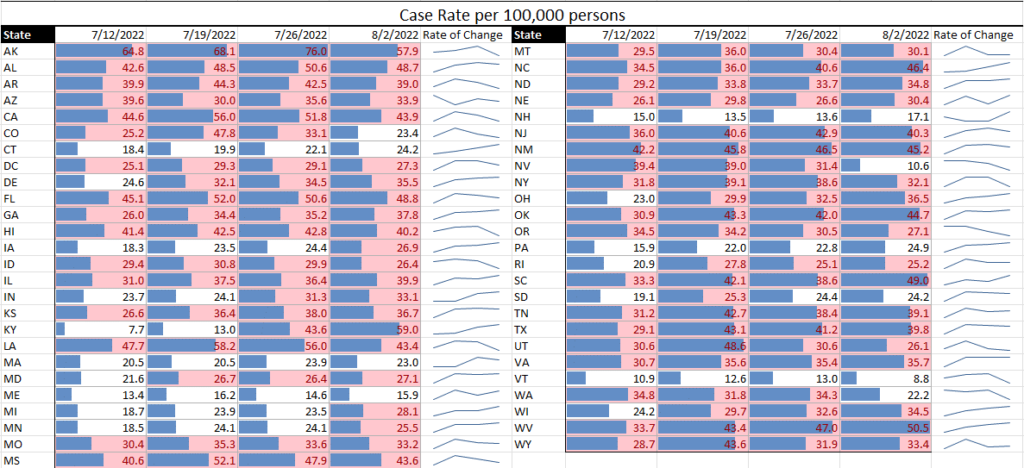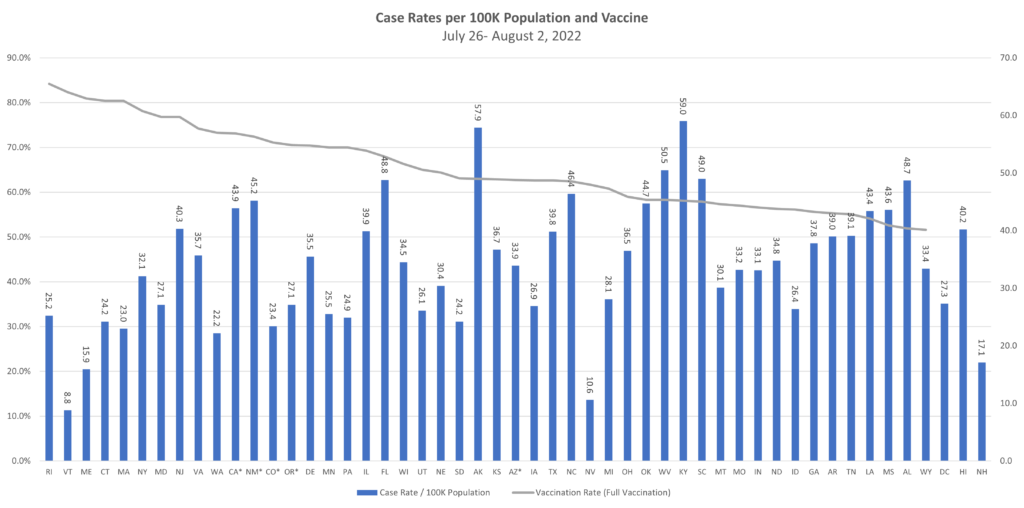Key Points:
- In today’s Recommendation for Industry, we discuss CDC’s reduction in COVID guidelines. Read more below.
- New York Times reports updates about COVID: Hospitalizations continue to increase, as they have through the summer, but they remain well below the peaks reached in previous surges. Nationwide, around 43,000 people are hospitalized with the coronavirus on an average day. The number of virus deaths announced each day is higher now than it was in early July, but it has held steady in recent weeks at around 440 fatalities per day. There is an average of roughly 130,000 new cases reported each day.
- Global COVID cases trend down, with rises in Japan, Korea: Global COVID-19 cases dropped again last week, as the BA.5-fueled disease burden shifts to some Asian nations, including Japan and South Korea. COVID activity appears to be declining, with a 9% drop last week compared to the week before, the WHO said. In the Western Pacific region, the highest jumps were in Japan, which reported a 42% increase, and South Korea, which reported a 25% rise compared to the week before. BA.5 prevalence rose from 63.8% to 69.6%, and BA.4 levels rose slightly, from 10.9% to 11.8%. HHS estimates that 7.7 million to 23 million Americans are experiencing long COVID, and that about 1 million are out of the workforce at any given time, amounting to $50 billion in lost earnings each year.
- U.S. CDC expected to ease COVID-19 guidelines for schools this week. The U.S. Centers for Disease Control and Prevention (CDC) is expected to ease its guidelines to control the spread of COVID-19, including in schools as soon as this week. The updated guidelines are expected to ease quarantine requirements for people exposed to the virus and would no longer recommend maintaining a six-foot distance at schools, according to the report. Currently, the agency requires people exposed to COVID and those not up to date on their vaccinations to stay at home and quarantine for at least five full days. The new guidelines would not require them to stay at home but instead to wear a mask and test at least five days after exposure.
Public Health & Food Safety:
- Monkeypox:
- California and Illinois join New York State, New York City, and San Francisco in declaring public health emergencies over monkeypox. Both states said the declaration will allow them to expand testing and vaccine access. The CDC has reported 662 more monkeypox cases, raising the nation’s total to 5,811 cases in 50 jurisdictions. There are now 11 deaths from monkeypox recorded in the global outbreak, as Peru confirmed a death from the virus. Health authorities said the death occurred in a 45-year-old with a weakened immune system due to an untreated HIV infection. Globally there are now 24,406 cases reported from 80 countries. The United Kingdom has 2,672 confirmed cases.
- WHO: US has biggest jump in monkeypox cases. In the last week of July, the United States saw the largest spike in cases, the WHO said. Of all case-patients with available data globally, 98.8% are men, and the median age is 37. Men 18 to 44 years old represent 76.7% of cases in the global outbreak. Sexual contact is the likely transmission event for 91.5% of patients.
- White House names new monkeypox response team. A FEMA administrator and a Centers for Disease Control and Prevention (CDC) director of HIV prevention now serve as the heads of the federal monkeypox response team. Robert Fenton, Jr., the current Federal Emergency Management Agency (FEMA) regional administrator for the American West, will be the response coordinator, and Demetre Daskalakis, MD, of the CDC, will serve as the deputy coordinator.
- 450 sick in Ferrero chocolate Salmonella outbreak. There have been more than 450 people sickened from a Salmonella outbreak linked to Kinder chocolate. The first reported patient was on January 7 in the UK, but still cases are continuing to be counted related to this outbreak. The outbreak hospitalized many people, mostly consisting of children younger than 10 years old. Of those hospitalized some were reported to have severe clinical symptoms including bloody diarrhea. Operations at Ferrero’s Arlon factory were suspended in April, which led to the recall of products made there. Potentially implicated chocolate was distributed to at least 113 countries. In May, Ferrero asked to be allowed to produce again and in June, the Federal Agency for the Safety of the Food Chain (FASFC) gave conditional approval for the plant in Belgium to restart. This approval lasts for three months. Raw materials and each batch of foodstuffs will be analyzed and only released if results are compliant.
- How predictive maintenance is changing the face of food manufacturing. Predictive maintenance is a proactive approach to maintenance management, and as its name suggests, the aim is to help predict when maintenance should be performed. It is a data-driven form of maintenance designed to analyze the current condition of equipment and machinery in order to plan for needed interventions. It has been estimated that predictive maintenance can reduce the mean time to repair (MTTR) by 60%. There are many benefits to predictive maintenance:
- Enabling early fault detection, i.e. halting impending failures
- Reduced risk of disruptions to production and downtime
- Improved performance of production-related assets
- Optimizing the lifespan of machinery and equipment
- Overall savings in production costs due to greater asset efficiencies
- Industry 4.0 is the next level of industrialization, one based on cloud computing, automation, connectivity, and large amounts of digital data. When Industry 4.0 is combined with the connected worker, they form the ‘smart factory.’
- Enabling early fault detection, i.e. halting impending failures
Recommendations for Industry
Indicators Point to CDC Reductions in COVID Control Guidelines
With a gradual decline in COVID cases trending in most states, along with reductions in the transmission rates over the last two weeks, as shown by TAG’s weekly matrix below, the CDC is expected to ease guidelines on transmission controls.
The changes, which were previewed to educators and public health officials and are expected to be publicly released soon, would include:
- The current requirement for those exposed to COVID to stay home and quarantine for at least five days would be reduced to no quarantine, instead recommending mask wearing and testing for at least five days after exposure.
- The current recommendation for six-foot distancing would be dropped.
- The test-to-stay guidance (involving frequent testing of those exposed to the virus, with isolation if positive, but allowed to attend school if negative and having no symptoms).
- Regular screening testing for COVID-19 in schools to monitor spread would be deemphasized.
With CDC’s expected change in guidance illustrating that Center is seeing a similar trajectory to that shown in TAG’s matrices, we are continuing to see an optimistic outlook for the continuing decline of COVID, supporting our previous stance that the virus is becoming more endemic than pandemic.
Risk Matrix:



In case you missed it:
- In Tuesday’s Recommendation for Industry, we discussed if there is a risk of monkeypox transmission within the workplace. Read more here.
- Moderna announces US contract for 66 million bivalent booster doses. Moderna announced a deal worth $1.76 billion with the US government to supply an initial 66 million doses for a new COVID-19 vaccine booster that targets the Omicron subvariant. Moderna’s bivalent shot covers the original SARS-CoV-2 and BA.4 and BA.5 subvariants. In a statement, Moderna said the contract also includes an option to buy 234 million additional booster doses. The company is developing two bivalent boosters, one for BA.4/BA.5, as recommended earlier this month by the US Food and Drug Administration (FDA), and the other for the BA.1 Omicron strain. The doses are projected to be available by mid-October, but efforts are underway to make the doses available sooner.
- ‘Living with COVID’: Where the pandemic could go next. Experts recently discussed that there could be up to a million infections a day during the winter in the United States. Questions are on the rise regarding when countries will move out of the COVID emergency phase and into a state of endemic disease where communities with high vaccination rates see smaller outbreaks. Many experts believed there would be a transition beginning in early 2022, but with the new variants of Omicron they were proven to be incorrect. The WHO has said each country still needs to approach new waves with all the tools in the pandemic armory- from vaccinations to interventions, such as testing and social distancing or masking.
- Fewer pregnant women had severe COVID amid Omicron, after vaccination. Investigators from South Korea retrospectively examined the electronic medical records of 224 pregnant women who tested positive for COVID-19 and 82 quarantine deliveries from Nov 1, 2020, to Mar 7, 2022, at a single hospital. Of the 224 women, 39 (17%) were vaccinated, and 185 (83%) were unvaccinated against COVID-19. Of the 224 women, 42% tested positive for COVID-19 amid Omicron, and 4.1% of vaccinated women and 25% of their unvaccinated counterparts in this period had severe illness. A total of 2.6% and 16.2%, respectively, required supplemental oxygen. Rates of moderate or severe maternal illness fell from 30.0% amid Delta to 10.6% amid Omicron, as did rates of infection (27.7% to 13.8%). The need for supplemental oxygen also dropped from 20.0% to 5.3%.
Public Health & Food Safety:
- Monkeypox:
- Health officials in India are urging parents to not panic when seeing cases of Chicken Pox and Hand, Foot, and Mouth disease. With monkeypox cases also being reported in the country, some are also confusing these other diseases for monkeypox.
- San Francisco, New York declare monkeypox emergencies. Both San Francisco and New York City have declared monkeypox emergencies as the cities continue to see cases surge among men who have sex with men (MSM) and a high demand for vaccines. On July 28th alone, New York City reported 1,251 new cases of monkeypox. San Francisco’s case count currently sits at 261 confirmed cases. The United States has a total case count of 4,907 within 48 states. Globally, there are more than 20,300 cases confirmed in non-endemic countries. Recorded last weekend, Brazil, Spain, and India all recorded the first monkeypox deaths outside of endemic countries in Central and West Africa. Spain recorded two deaths, with Brazil and India each recording a single death. So far in the current outbreak, there have been 10 deaths from the poxvirus.
- HHS promises 1.1 million monkeypox vaccines in coming weeks. In the coming weeks, 1.1 million doses of the Jynneos monkeypox vaccine will have been made available for many Americans. The four most common symptoms seen by US clinicians are rash, malaise, fever, and swollen lymph nodes. The CDC announced that monkeypox will now be a nationally notifiable disease as of Aug 1. This means states will be required to report confirmed or suspected monkeypox cases to the CDC within 24 hours of discovery.
- FDA releases updates to Cyclospora action plan: The U.S. Food and Drug Administration has released new updates detailing the agency’s Cyclospora prevention and research efforts. The action plan was developed by the agency’s Cyclospora Task Force and details the FDA’s strategy for reducing the public health burden of foodborne cyclosporiasis in the United States. It also defines the agency’s priorities for Cyclospora food safety research and supports ongoing efforts to combat foodborne illness. A full listing of the task force’s latest accomplishments and their current Cyclosporaprevention and research efforts along with an updated factsheet on Cyclosporiasis and Fresh Produce can be found here.
- Cereals and grains top of FAO and WHO’s risk ranking. Based on a request from the Codex Committee on Food Hygiene (CCFH), the Food and Agriculture Organization of the United Nations (FAO) and World Health Organization (WHO) ranked the foods of greatest concern from a microbiological food safety perspective. Cereals and grains scored highly across all the criteria. This is not surprising given the importance of the commodities and products in this category as staples in the global food supply, said the report. For cereals and grains, the most common interventions were dry heat treatments, chemical treatments, and irradiation. Spices and dried herbs were also reported on having microbiological hazards. Salmonella and the spore-forming organisms Bacillus cereus and Clostridium perfringens were considered foodborne pathogens of particular concern. It covered chili and red pepper, cinnamon, turmeric, cumin, black pepper, oregano, nutmeg, rosemary, saffron, and basil.
- CDC finds rare bacterium behind melioidosis in US soil, water. The bacterium, Burkholderia pseudomallei, was identified through soil and water sampling in the Gulf Coast region of Mississippi, the Centers for Disease Control and Prevention (CDC) said in a news release. Melioidosis is incredibly rare in the United States, with roughly 12 cases a year reported, and most cases occur in people who have travelled to regions of the world where B pseudomallei is commonly found in soil and water. The CDC says B pseudomallei has likely been in the region since 2020 and is now considered locally endemic, and their modeling suggests the environmental conditions of the Gulf Coast states are conducive to the growth of the bacterium. But more environmental sampling is needed to determine where else it might be found in the country. Although the risk to the general population is considered very low, the CDC said residents of the Gulf Coast of Mississippi who have conditions that could put them at higher risk of severe melioidosis infection or death—such as diabetes, chronic kidney disease, chronic lung disease, and excessive alcohol use—should avoid contact with soil or muddy water and protect open wounds.
- Salmonella in poultry, the issues and solutions, hearing from the experts. Salmonella serotype Enteritidis and Typhimurium are responsible for multiple cases linked to poultry and in recent years Salmonella Infantis has become a re-occurring, emerging and persistent serotype. FSIS has a list of strategies in order to prevent Salmonella in poultry that can be found here. Also discussed was how utilizing serotype and quantification data to address Salmonella in poultry can be a factor for solution. A reasoning for the contaminated poultry was due to a study that hypothesized that the international trade of infected breeding stocks causes the global spread of the pathogen.





